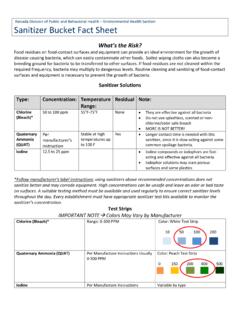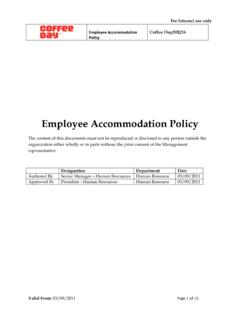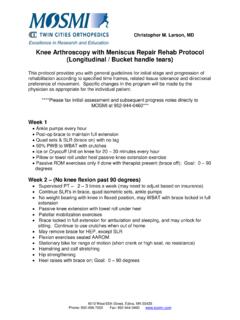Transcription of TASSEL 5.0 Pipeline Command Line Interface
1 TASSEL Pipeline Command Line Interface : Guide to using TASSEL Pipeline Terry Casstevens ( ) Institute for Genomic Diversity, Cornell University, Ithaca, NY 14853-2703 July 31, 2019 Prerequisites1 Source Code1 Install1 Execute2 Increasing Heap Size2 Setting Logging to Debug or Standard (With optional filename)2 Examples2 Examples (XML Configuration Files)2 Setting Global Plugin Parameter Values (-configParameters)3 Usage3 Pipeline Controls3 Data4 Filter8 Analysis9 Results11 Prerequisites Java JDK or later ( ). Source Code git clone Install git clone OR 1 Execute On Windows, use to execute the Pipeline . In UNIX, use to execute the Pipeline . If you are using a Bash Shell on Windows, you may need to change the following line to use a ; instead of a.
2 My $CP = join(":", @fl); To launch the TASSEL GUI that automatically executes a Pipeline , use or instead of or respectively. These scripts have a $top variable that can be changed to the absolute path of your installation. That way, you can execute them any directory. Increasing Heap Size To modify the initial or maximum heap size available to the TASSEL Pipeline , either edit or specify values via the Command line.. -Xms512m -Xmx10g -fork1 .. Setting Logging to Debug or Standard (With optional filename) . -debug [<filename>] .. -log [<filename>] .. Examples . -fork1 -h -ld -ldd png -o . -fork1 -h -ld -ldd png -o . -fork1 .. -fork2 .. -combine3 -input1 -input2 .. -fork4 -<flag> -input3 Examples (XML Configuration Files) This Command runs the TASSEL Pipeline according to the specified configuration Configuration files are standard XML notation.
3 The tags are the same as the below documented flags although no beginning dash is used. See the example_pipelines directory for some common XML configurations.. -configFile 2 This Command creates the XML configuration file from the original Command line flags. Simply insert the -createXML and filename at the beginning. Only the XML is created. It does not run the . -createXML -fork1 .. This Command translates the specified XML configuration file back into the original Command line It does not run the . -translateXML Setting Global Plugin Parameter Values (-configParameters) This flag defines plugin parameter values to be used during a TASSEL execution. Values are used in the following priority (highest to lowest). specified value ( -method Dominance_Centered_IBS) by -configParameters <filename> default value Example ( ).
4 Host=localHost user=sqlite password=sqlite DB=/Users/terry/temp/ DBtype=sqlite Example . -configParameters Usage Pipeline Controls -fork<id> This flag identifies the start of a Pipeline segment that should be executed sequentially. <id> can be numbers or characters (no spaces). No space between -fork and <id> either. Other flags can reference the <id>. -runfork<id> NOTE: This flag is no longer required. The Pipeline will automatically run the necessary 3 forks. This flag identifies a Pipeline segment to execute. This will usually be the last argument. This explicitly executes the identified Pipeline segment. This should not be used to execute Pipeline segments that receive input from other Pipeline segments. Those will start automatically when it receives the input.
5 -input<id> This specifies a Pipeline segment as input to the plugin prior to this flag. That plugin must be in the current Pipeline segment. Multiple of these can be specified after plugins that accept multiple inputs.. -fork1 -h -fork2 -r -combine3 -input1 -input2 -intersect . -fork1 -h -fork2 -includeTaxaInFile -input1 -export file1 -fork3 -includeTaxaInFile -input1 -export file2 -inputOnce<id> This specifies a Pipeline segment as a one-time input to a -combine. As such, this flag should follow -combine. After the -combine has received data from this input, it will use it for every iteration. Whereas -combine waits for data specified by -input each iteration. Multiple of these can be specified. -combine<id> This flag starts a new Pipeline segment with a CombineDataSetsPlugin at the beginning.
6 The CombineDataSetsPlugin is used to combine data sets from multiple Pipeline segments. Follow this flag with -input<id> and/or -inputOnce<id> flags to specify which Pipeline segments should be combined. -printMemoryUsage This prints memory used. Can be used in multiple places in the Pipeline .. -fork1 -h -printMemoryUsage -KinshipPlugin -endPlugin -printMemoryUsage Data If the filename to be imported begins with http , it will be treated as an URL. -t <trait file> Loads trait file as numerical data. -s <PHYLIP file> Loads PHYLIP file. -r <phenotype file> Same at -t 4 -k <kinship file> Loads kinship file as square matrix. -q <population structure file> Loads population structure file as numerical data. -h <hapmap file> Loads hapmap file (. or . ) -h5 <HDF5 file> Loads HDF5 Alignment file (.)
7 -plink -ped <ped filename> -map <map filename> Loads Plink format given ped and map files. -fasta <filename> Loads FASTA file. -table Loads a Table ( exported from LD, MLM). -vcf <filename> Loads VCF file. -importGuess <filename> Uses TASSEL Guess function to load file. -hdf5 Schema <hdf5 filename> This inspects the HDF5 file for it s internal structure / schema../run_pipeline -hdf5 Schema -export -projection <filename> . -vcf -projection -export -sortPositions Sorts genotype positions during import (Supports Hapmap, Plink, VCF) -convertTOPMtoHDF5 <TOPM filename> This converts TOPM file into a HDF5 formated TOPM file. New files extension will be .. -convertTOPMtoHDF5 -retainRareAlleles < true | false> Sets the preference whether to retain rare alleles.
8 Notice this has no meaning for Nucleotide data. Only data that has more than 14 states at a given site (not including Unknown) are affected. If true, states more rare than the first 14 by frequency are changed to Rare (Z). If false, they are changed to Unknown (N). -union This joins (union) input datasets based taxa. This should follow a -combine specification. -intersect This joins (intersect) input datasets based taxa. This should follow a -combine specification. -separate < > This separates an input into its components if possible. For example, alignments separated by chromosome (locus). For alignments, optionally specify list of chromosomes (separated by commas and no spaces) to separate. Specifying nothing returns all chromosomes. Example: -fork1 -h -separate 3,6 -export -homozygous This converts any heterozygous values to unknown.
9 5 . -h -homozygous -export -mergeGenotypeTables Merges multiple Alignments regardless of taxa or site name overlap. Undefined taxa / sites are set to UNKNOWN. Duplicate taxon / site set to last Alignment processed. Example: -fork1 -h -fork2 -h -combine3 -input1 -input2 -mergeGenotypeTables -export -mergeAlignmentsSameSites -input <files> -output <filename> Merges Alignments assuming all sites are the same in all Hapmap files. Input files separated by commas without spaces. The resulting file may have incorrect major/minor alleles, strand, center, etc. It uses values from first specified input file. Checks that Site Name, Chromosome, and Physical Position match for each site. Example: -fork1 -mergeAlignmentsSameSites -input , -output temp -export <file1,file2.
10 > Exports input dataset to specified filename(s). If no -exportType follows this parameter, the exported format will be determined by the type of input ( Genotype Tables will default to Hapmap format, Distance Matrix with default to SqrMatrix). Other exportable datasets only have one format option. Therefore, there is no need to specify -exportType. Specify none, one, or multiple filenames matching the number of input data sets. If no filenames, the files will be named the same as the input data sets. If only one specified for multiple data sets, a count starting with 1 will be added to each resulting file. If multiple filenames (separated with commas but no spaces), there should be one for each input. When exporting Hapmap files, if the extension is . , the file will be gzipped.






